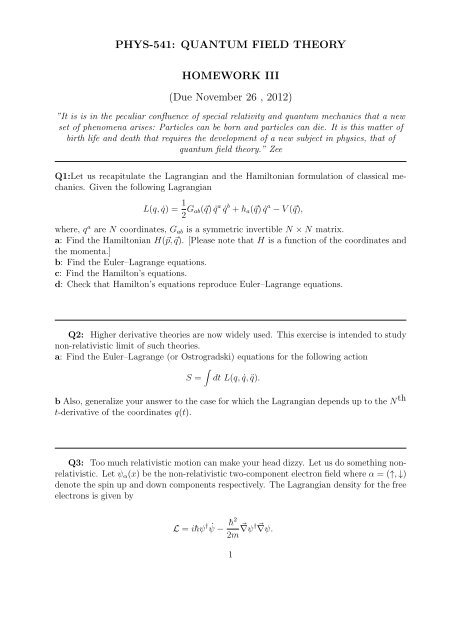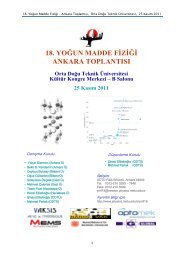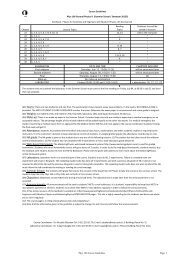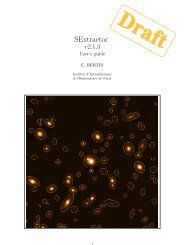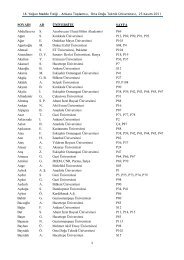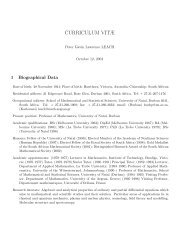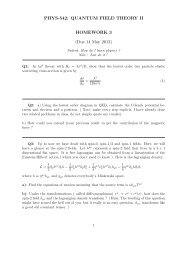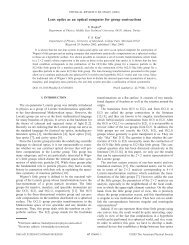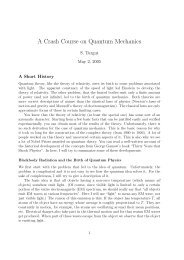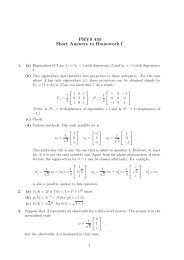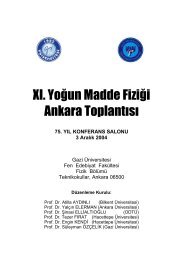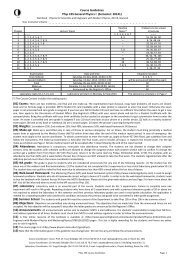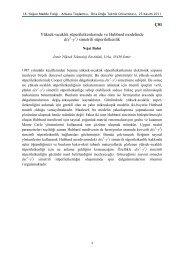Homework 3
Homework 3
Homework 3
Create successful ePaper yourself
Turn your PDF publications into a flip-book with our unique Google optimized e-Paper software.
PHYS-541: QUANTUM FIELD THEORY<br />
HOMEWORK III<br />
(Due November 26 , 2012)<br />
”It is is in the peculiar confluence of special relativity and quantum mechanics that a new<br />
set of phenomena arises: Particles can be born and particles can die. It is this matter of<br />
birth life and death that requires the development of a new subject in physics, that of<br />
quantum field theory.” Zee<br />
Q1:Let us recapitulate the Lagrangian and the Hamiltonian formulation of classical mechanics.<br />
Given the following Lagrangian<br />
L(q, ˙q) = 1 2 G ab(⃗q) ˙q a ˙q b + h a (⃗q) ˙q a − V (⃗q),<br />
where, q a are N coordinates, G ab is a symmetric invertible N × N matrix.<br />
a: Find the Hamiltonian H(⃗p, ⃗q). [Please note that H is a function of the coordinates and<br />
the momenta.]<br />
b: Find the Euler–Lagrange equations.<br />
c: Find the Hamilton’s equations.<br />
d: Check that Hamilton’s equations reproduce Euler–Lagrange equations.<br />
Q2: Higher derivative theories are now widely used. This exercise is intended to study<br />
non-relativistic limit of such theories.<br />
a: Find the Euler–Lagrange (or Ostrogradski) equations for the following action<br />
∫<br />
S = dt L(q, ˙q, ¨q).<br />
b Also, generalize your answer to the case for which the Lagrangian depends up to the N th<br />
t-derivative of the coordinates q(t).<br />
Q3: Too much relativistic motion can make your head dizzy. Let us do something nonrelativistic.<br />
Let ψ α (x) be the non-relativistic two-component electron field where α = (↑, ↓)<br />
denote the spin up and down components respectively. The Lagrangian density for the free<br />
electrons is given by<br />
L = i¯hψ † ˙ψ − ¯h2<br />
2m ⃗ ∇ψ † ⃗ ∇ψ.<br />
1
a )Find the total momentum ⃗ P and the total angular momentum ⃗ J.<br />
In the presence of a uniform magnetic field in the x 3 direction, the Lagrangian density<br />
becomes<br />
L = i¯hψ † ˙ψ − 1<br />
2m (i¯h⃗ ∇ + e c ⃗ A)ψ † (−i¯h ⃗ ∇ + e c ⃗ A)ψ − e¯h<br />
2mc ⃗ Bψ † ⃗σψ.<br />
In the symmetric gauge, which I happen to like, the field reads<br />
⃗A = (− 1 2 Bx 2, 1 2 Bx 1, 0),<br />
⃗ B = (0, 0, B).<br />
Show that the action is invariant under a rotation around the x 3 -axis and find the third<br />
component of the angular momentum (J 3 ).<br />
b) The action is not explicitly invariant under translations along the x 1 or the x 2 axis.<br />
However, show that it is invariant under the following transformation:<br />
⃗x → ⃗x ′ = ⃗x + ⃗a<br />
ψ(t, ⃗x) → ψ ′ (t, ⃗x ′ ) = e ieB/2¯hc(a 2x 1 −a 1 x 2 ) ψ(t, ⃗x).<br />
c) According to our good old lady Noether, there are three associated conserved quantities<br />
( which are called the generalized momenta ⃗ Π ). Find these conserved quantities.<br />
Q3: Answer the following questions.<br />
a: In D + 1 dimensions, how many generators does the Poincare group have What<br />
do they correspond to<br />
b : If p µ is the energy-momentum vector of a particle in 5 dimensions, how does p µ p ν<br />
transform under the Lorentz group Find the parts which transform irreducibly<br />
c :Why do we label particles/fields with their masses and spins <br />
d To construct a Dirac spinor ψ D , why do we take a 2-dimensional complex left-handed<br />
Weyl spinor and a right-handed Weyl spinor and combine them into a 4-spinor <br />
e Pauli-Lubanski vector is defined as 2W µ ≡ ɛ µνρσ M νρ P σ<br />
Compute the following<br />
a) P µ W µ b) W µ if (M σρ ) αβ = i(g αρ g σβ − g ασ g βρ )<br />
2
Q4 : a) Given a left-handed Weyl spinor ψ L ∈ (1/2, 0), show that σ 2 ψL ∗ is a righthanded<br />
spinor. ( Here σ 2 is the usual second Pauli-matrix with purely imaginary entries.<br />
b) Given a right-handed Weyl spinor ψ R ∈ (0, 1/2), show that σ 2 ψ ∗ R is a left-handed spinor.<br />
( Here σ 2 is the usual second Pauli-matrix with purely imaginary entries.<br />
c) Charge conjugation operation transforms a left-handed Weyl spinor into a right handed<br />
one vice versa. Define charge conjugation on Weyl spinors as<br />
ψ c L ≡ iσ 2 ψ ∗ L,<br />
ψ c R ≡ −iσ 2 ψ ∗ R<br />
Using these definitions, construct a bispinor , call it the Dirac spinor ψ D which satifies<br />
(ψ c D) c = ψ D .<br />
d) Again, using these definitions, construct a bispinor , call it the Majorana spinor ψ M<br />
which satisfies ψ c M = ψ M .<br />
3


